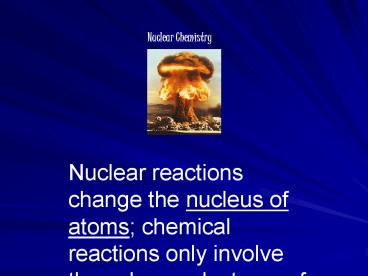Nuclear Chemistry - PowerPoint PPT Presentation
1 / 30
Title:
Nuclear Chemistry
Description:
Roentgen- x-rays (1895) Becquerel- discovered that phosphorescent uranium salts give off radiation ... Marie & Pierre Curie- worked with Becquerel's results to ... – PowerPoint PPT presentation
Number of Views:86
Avg rating:3.0/5.0
Title: Nuclear Chemistry
1
Nuclear Chemistry
Nuclear reactions change the nucleus of atoms
chemical reactions only involve the valence
electrons of an atoms.
2
Radioactivity- the process in which some
substances spontaneously emit radiation
(particles and rays of energy).
3
Radiation
- High amount of Radiation
- X-rays
- Cosmic
- Low amount of Radiation
- Radio
- Microwaves
4
Nuclear History
- Roentgen- x-rays (1895)
- Becquerel- discovered that phosphorescent
uranium salts give off radiation - Marie Pierre Curie- worked with Becquerels
results to identify 2 new elements, polonium and
radium. - Rutherford- identified 3 types of radiation
5
6
Types of radiation
- Alpha
- Beta
- Gamma
- Positron
- Electron capture
We will focus on the first three types.
7
(No Transcript)
8
Alpha radiation
9
Beta radiation
10
Gamma radiation
11
(No Transcript)
12
Balancing Nuclear Equations
13
alpha decay
- 23892U ? 23490Th _______
14
- 23892U ? 23490Th 42He
- 238 ? 234 4 mass
- 92 ? 90 2 atomic
15
Alpha decay a
- You try!!!
- 22688 Ra ? _____ _____
16
Alpha decay a
- 22688 Ra ? 4 2 He 222 86 Rn
- 226 ? 4 222 mass
- 88 ? 2 86 atomic
17
Beta decay
- 23490Th ? ______ ______
18
Beta decay
- 23490Th ? 23491Pa 0-1e
- 234 ? 234 0 mass
- 90 ? 91 -1 atomic
19
You try!!!
- 6027Co ? 0-1 e ______
- 230 90 Th ? 4 2 He _______
- 146C ? 147 N _____
20
- 6027Co ? 0-1 e 60 28 Ni
21
- 6027Co ? 0-1 e 60 28 Ni
- 230 90 Th ? 4 2 He 226 88 Ra
22
- 6027Co ? 0-1 e 60 28 Ni
- 230 90 Th ? 4 2 He 226 88 Ra
- 146C ? 147 N 0 -1 e
23
- Write the nuclear reaction for the decay of
Am-241. An alpha particle is released.
- 24195 Am ? 42 He 23793Np
24
- Many radioactive elements undergo a series of
decay reactions, releasing different particles
and raysa decay series. - Ex. Uranium-238 has 14 decays to reach a stable
nucleus of lead-206. - worksheet
25
Half Life
- Measures the rate of decay of radioisotopes
- Information of half-life helps scientists to plan
how long hazardous wastes must be stored - 1 half-life time it takes for ½ of the atoms in
a sample to decay
26
The half life of element X is 12 years. If you
begin with a sample of 148.0 g, how much is left
in 60 years?
27
Nuclear Uses
- Medicine- X rays, cancer treatment, radiotracers
(ex. Iodine-131 is used to pinpoint thyroid gland
disorders) - Energy- using nuclear fission, nuclear reactors
produce a large amount of energy using a small
amount of initial nuclear mass (ex. Uranium)
28
Nuclear Uses
- Radioisotopes in everyday products- smoke
detectors use Americum-241. - Am- 241 decays and gives off alpha
particles. These alpha particles ionize the air
by producing a current. When smoke interrupts
this process, an alarm is triggered in the smoke
detector.
29
Fissionsplitting of nuclei
Fission is used in nuclear reactors to produce
energy.
30
Fusioncombining of two nuclei
Fusion occurs in the sun, where 4 hydrogen atoms
and 2 beta particles fuse to form a helium atom.































